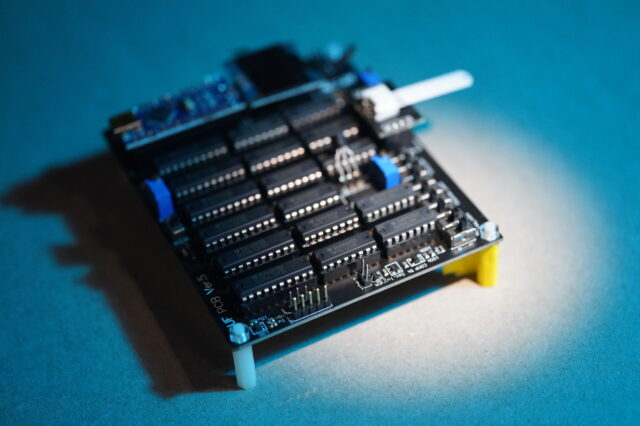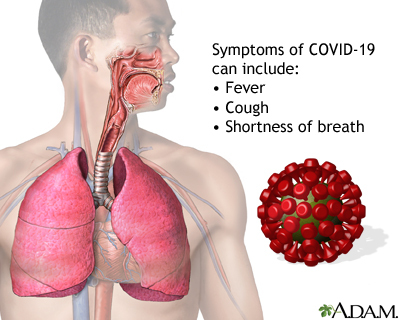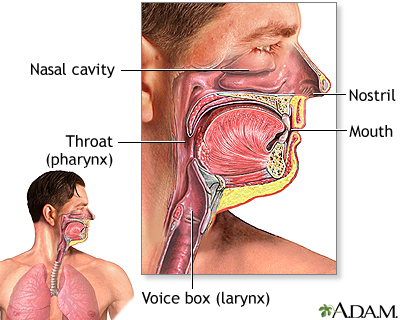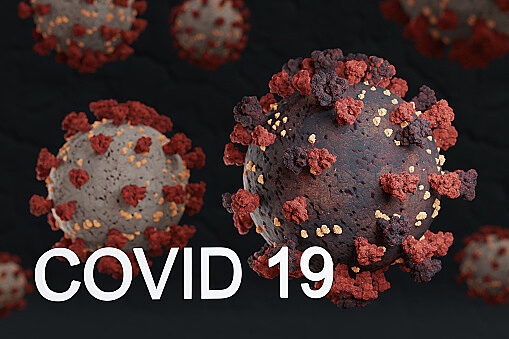Definition
Testing for the virus that causes COVID-19 involves taking a mucus sample from your upper respiratory tract. This test is used to diagnose COVID-19.
The COVID-19 virus test is not used to test your immunity to COVID-19. To test if you have antibodies against the SARS-CoV-2 virus, you need a COVID-19 antibody test taken from a blood sample.
Alternative Names
COVID 19 - Nasopharyngeal swab; SARS CoV-2 test; COVID-19 PCR test
How the Test is Performed
Testing is usually done in one of two ways. For a nasopharyngeal test, you will be asked to cough before the test begins and then tilt your head back slightly. A sterile, cotton-tipped swab is gently passed through a nostril and into the nasopharynx. This is the uppermost part of the throat, behind the nose. The swab is left in place for several seconds, rotated, and removed. This same procedure may be done on your other nostril.
For an anterior nasal test, the swab will be inserted into your nostril no more than 3/4 of an inch (2 centimeters). The swab will be rotated 4 times while pressing against the inside of your nostril. The same swab will be used to collect samples from both nostrils.
Tests may be done by a health care provider at an office, drive-through, or walk-up location. Check with your local health department to find out where testing is available in your area.
At-home testing kits (self-tests) are available over-the-counter. Most kits have you collect a sample using a nasal swab, and you can get results at home in minutes. Be sure to follow the instructions that come with the kit,
There are two types of virus tests available that can diagnose COVID-19:
- Polymerase chain reaction (PCR) tests (also called Nucleic Acid Amplification Tests [NAATs]) detect the genetic material of the virus that causes COVID-19. The samples are usually sent to a laboratory for testing, and results are usually available in 1 to 3 days. There are also rapid PCR diagnostic tests that are run on specialized equipment on-site, for which the results are available in several minutes. PCR tests tend to be the most reliable tests, whether or not you have symptoms.
- Antigen tests detect specific proteins on the virus that causes COVID-19. Antigen tests are rapid diagnostic tests, which means results are available in several minutes. Self-tests taken at home are antigen tests. These tests are not as reliable as PCR tests, especially if you do not have symptoms.
- Rapid diagnostic tests of any kind are less accurate than the regular PCR test. If you get a negative result on a rapid test, but have symptoms of COVID-19, your provider may do a non-rapid PCR test.
How to Prepare for the Test
No special preparation is needed.
How the Test will Feel
Depending on the type of test, you may have slight or moderate discomfort, your eyes may water, and you may gag.
Why the Test is Performed
The test identifies the SARS-CoV-2 virus (severe acute respiratory syndrome coronavirus 2), which causes COVID-19.
Normal Results
The test is considered normal when it is negative. A negative test means that at the time you were tested, you probably didn't have the virus that causes COVID-19 in your respiratory tract. But you can test negative if you were tested too early after infection for COVID-19 to be detected. And you can have a positive test later if you are exposed to the virus after you were tested. Also, rapid diagnostic tests of any kind are less accurate than the regular PCR test, and either test may remain positive for weeks after you've recovered from the illness.
For this reason, if you have symptoms of COVID-19 or you are at risk for contracting COVID-19 and your first test result was negative, your provider may recommend being retested at a later time. A single negative self-test will not rule out infection. If you used a self-test, you should test again in 24 to 48 hours. Or, your provider may recommend a PCR test to confirm your results.
What Abnormal Results Mean
A positive test means that you are infected with SARS-CoV-2. You may or may not have symptoms of COVID-19, the illness caused by the virus. Whether you have symptoms or not, you can still spread the illness to others. You should isolate yourself in your home and learn how to protect others from developing COVID-19. You should do this immediately while waiting for more information or guidance. You should stay at home and away from others until you meet the guidelines for ending home isolation. Contact your provider or local health department for their recommendations.
References
Centers for Disease Control and Prevention website. COVID-19: Self-testing at home or anywhere. www.cdc.gov/coronavirus/2019-ncov/testing/self-testing.html. Updated September 6, 2022. Accessed January 23, 2023.
Centers for Disease Control and Prevention website. COVID-19: Interim guidelines for collecting and handling of clinical specimens for COVID-19 testing. www.cdc.gov/coronavirus/2019-ncov/lab/guidelines-clinical-specimens.html. Updated July 15, 2022. Accessed January 23, 2023.
Centers for Disease Control and Prevention website. COVID-19: Overview of testing for SARS-CoV-2, the virus that causes COVID-19. www.cdc.gov/coronavirus/2019-ncov/hcp/testing-overview.html. Updated September 28, 2022. Accessed January 23, 2023.
Centers for Disease Control and Prevention website. COVID-19 testing: what you need to know. www.cdc.gov/coronavirus/2019-ncov/symptoms-testing/testing.html. Updated September 28, 2022. Accessed January 23, 2023.




